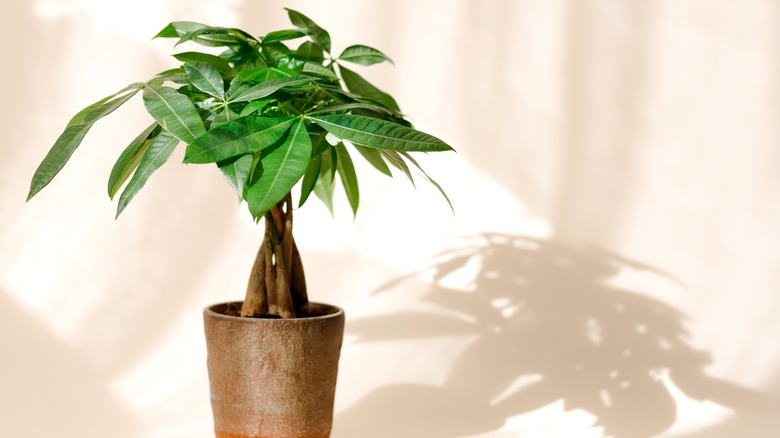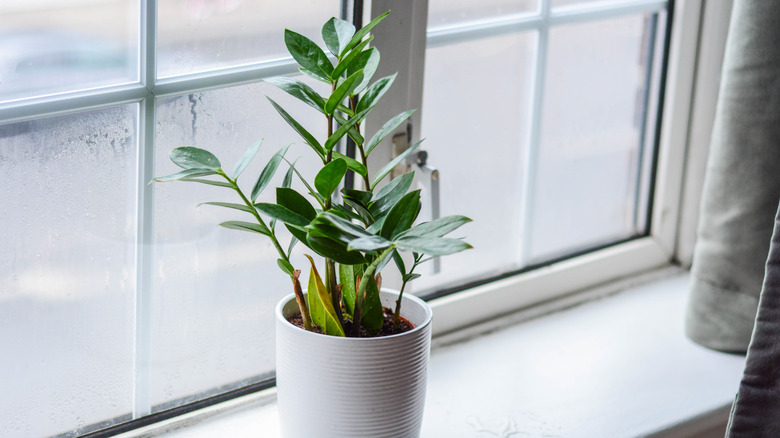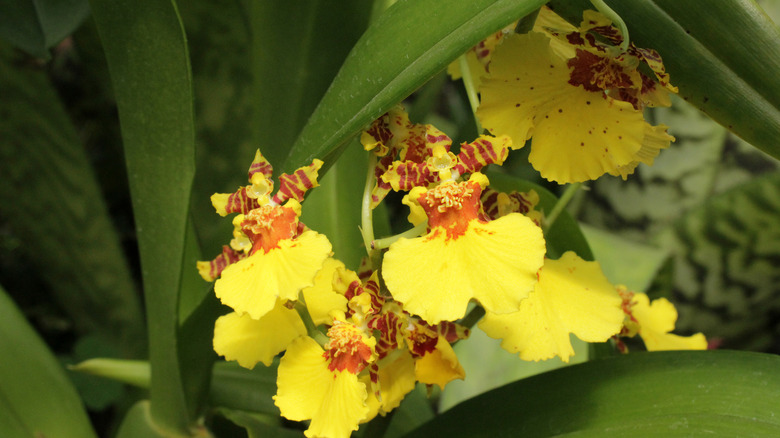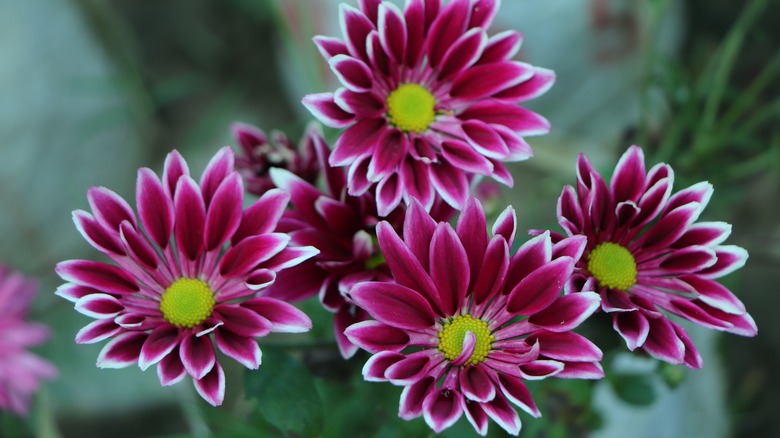15 Lucky Plants To Have In Your Home For The Lunar New Year
If you're someone who lives in an area that welcomes the New Year on January 1, you might not be aware that many people around the world are still preparing for the Lunar New Year, which happens much later in the month. If you do celebrate the Lunar New Year, you might prepare by planning a reunion dinner, going out to buy decorations, or by cleaning your house and positioning your luckiest plants for good fortune. In some cultures, it's not uncommon to grow houseplants such as anthuriums, orchids, bromeliads, and lucky bamboo in order to bring wealth, love, peace, blessings, and prosperity into your home for yourself and your family, notes The Chinese Zodiac.
Even if your thumb is not the greenest, you can still participate in this yearly tradition. Many of the plants commonly grown for luck and other symbolic reasons are adaptable, drought-resistant, neglect-tolerant, and very hard to kill. In this collection, we've found several houseplants considered by a variety of countries to provide you with good fortune as we prepare to celebrate the Lunar New Year.
1. Lucky bamboo
Lucky bamboo (Dracaena sanderiana) is a member of the Asparagaceae family known for its slow-growing, bamboo-like stems that feature green or variegated lance-shaped leaves, as described by Missouri Botanical Garden. This houseplant is a necessity for any Lunar New Year celebration as it is thought to bring luck and positive energy into the home.
Bloom Season: Rarely flowers indoors
USDA Growing Zone: 9 to 12
Growing Conditions: Medium to low indirect light
Soil Type: Evenly moist substrate
Size: 3 to 5 feet tall and wide
2. Money tree
Money trees (Pachira aquatica) can be grown year-round for fortune and prosperity. As noted by the University of Arizona, this houseplant typically grows 6 to 9 feet tall indoors. However, it will take some time before it reaches these heights. Notice each leaf separates into five leaflets, this number is considered significantly lucky in Chinese culture, providing you even more reason to cultivate this tree as we start the new year.
Bloom Season: Spring
USDA Growing Zone: 9 to 11
Growing Conditions: Indirect sunlight
Soil Type: Well-draining
Size: Up to 9 feet tall
3. Moth orchid
Moth orchids (Phalaenopsis spp.) are frequently recommended as houseplants for many different reasons. They are easy to grow, their flowers are large and ornamental, and for many, they symbolize fertility and abundance. If you are unfamiliar with orchid care, moth orchids are a good place to start. According to University of Maryland Extension, they can grow and flower under most conditions indoors.
Bloom Season: Winter to spring
USDA Growing Zone: 11 to 12
Growing Conditions: Bright indirect light
Soil Type: Loose bark or another loose potting mix
Size: No larger than 3 ft tall
4. Prayer plant
The prayer plant (Maranta leuconeura) got its name from its large red, green, and white leaves that fold together at night as if in prayer, mentions Missouri Botanical Garden. It thrives as a houseplant due to its love of indirect light and warm temperatures. This interesting plant doesn't just make it onto our list for its unique foliage, but also because it's considered lucky in some cultures.
Bloom Season: Rarely flowers indoors
USDA Growing Zone: 11 to 12
Growing Conditions: Medium indirect light
Soil Type: Well-draining potting mix
Size: 6 to 12 inches tall and wide
5. ZZ plant
The ZZ plant (Zamioculcas zamiifolia), which is sometimes called the fortune tree, is a resilient little plant that features dark green, glossy leaves on upright stems. It can be grown in a dark room with little water for some time, per University of Florida. However, you'll want to show it off and care for it kindly in order to reap its feng shui benefits during the Lunar New Year.
Bloom Season: Rarely flowers indoors
USDA Growing Zone:9 to 10
Growing Conditions: Medium to low indirect light
Soil Type: Well-drained potting mix
Size: 16 to 30 inches tall
6. Dragon tree
Dragon trees (Dracaena marginata) are gorgeous houseplants that can grow quite tall if you aren't vigilant about pruning them. They are loved for their sword-like and variegated foliage as well as their stems which can be trained into shapes, notes North Carolina State Extension. The dragon tree's ability to live and grow through times of drought makes it a symbol of perseverance and knowledge, so it's frequently grown during the new year.
Bloom Season: Spring
USDA Growing Zone: 10 to 12
Growing Conditions: Medium to bright light
Soil Type: General-purpose potting soil
Size: 16 to 40 inches tall
7. Dancing lady orchid
Another lucky orchid is the dancing lady (Oncidium spp.). According to Royal Horticultural Society, there are over 700 Oncidium species and more hybrids. They're well known for their yellow blooms, yet they can produce flowers in several colors. Some popular varieties include Oncidium leucochilum, Oncidium tigrinum, and Oncidium sarcodes.
Bloom Season: Blooms occur when new growth matures, 1 to 2 times per year
USDA Growing Zone: 9 to 12
Growing Conditions: Bright indirect light
Soil Type: Bark-based, well-draining potting mix
Size: 1 to 10 feet tall and 1 to 2 feet wide, depending on the cultivar
8. Desert rose
The desert rose (Adenium obesum) is a succulent native to Africa, the Arabian Peninsula, and Tanzania. It has a tree-like growth habit, however, when grown in a container, it rarely reaches more than 9 feet tall. Its trunk is bulbous, much like the ponytail palm, but its stems twist for a more interesting shape, explains North Carolina State Extension.
Bloom Season: Summer
USDA Growing Zone: 11 to 12
Growing Conditions: Bright direct or indirect light
Soil Type: Dry and well-draining potting mix
Size: 3 to 9 feet tall and 3 to 5 feet wide
9. Peace lily
The peace lily (Spathiphyllum spp.) is thought to bring good health, and it turns out that it really can! According to Clemson Cooperative Extension, peace lilies make good indoor plants because of their ability to purify indoor air of toxins. These may include benzene, formaldehyde, ethylene, and ammonia. To start your year with good health, try growing this plant in one of your home's north-facing windows.
Bloom Season: Spring
USDA Growing Zone: 10 to 11
Growing Conditions: Bright indirect light
Soil Type: Well-draining potting mix
Size: 1 to 6 feet tall
10. Chinese money plant
The Chinese money plant (Pilea peperomioides) is among the most popular plants that are grown for Lunar New Year celebrations. Tending to this plant at home is rumored to bring wealth and fortune to you and your family. It is native to southwestern China, but is now grown in homes around the world, notes Logee's.
Bloom Season: Winter
USDA Growing Zone: 10 to 11
Growing Conditions: Bright to medium indirect light
Soil Type: Well-draining potting mix
Size: 8 to 12 inches tall
11. Bodhi tree
The Bodhi tree (Ficus religiosa), is also known as the sacred fig. Per the Urban Forest Ecosystems Institute at Cal Poly, the tree is sacred in Buddhism and used for treating issues such as asthma, diabetes, epilepsy, and infections. When grown outdoors, it can reach maximum heights of 100 feet, but it can also be grown indoors as a bonsai tree with the right technique.
Bloom Season: Rarely flowers indoors
USDA Growing Zone: 10 to 12
Growing Conditions: Medium to bright light
Soil Type: Loamy or sandy alkaline potting mix
Size: Up to 3 feet indoors
12. Bromeliads
Bromeliads (Guzmania spp.) are great plants for infusing your home with positive feng shui. These plants, which are members of the pineapple family, have been used for years to improve the chi energy within the home. North Carolina State Extension notes that bromeliads are also among the most ornamental houseplants.
Bloom Season: Summer
USDA Growing Zone: 10 to 12
Growing Conditions: Bright to medium indirect light
Soil Type: Well-draining, organically rich potting mix
Size: 6 inches to 3 feet tall and wide
13. Chrysanthemum
Chrysanthemums (Chrysanthemums spp.) are popular indoor and outdoor flowers that bloom from summer to winter, per Utah State University. To live, they need bright light, moist potting soil, and stalking whenever their tall stems require support. In China, the long-lasting blooms are considered symbols of longevity, so they are used to welcome good fortune at the beginning of a new year.
Bloom Season: Summer to fall
USDA Growing Zone: 5 to 9
Growing Conditions: Bright indirect light
Soil Type: Evenly moist and well-draining potting mix
Size: Up to 3 feet tall and wide
14. Jade plant
Jade plants (Crassula argentea) have a long history of ushering good luck and fortune into homes and office buildings throughout China and other countries around the world. They are also known to be very easy to care for because they can survive without much attention and adapt to nearly all light conditions, per University of Florida.
Bloom Season: Spring
USDA Growing Zone: 10 to 11
Growing Conditions: Bright, medium, or low indirect light
Soil Type: Well-draining and acidic potting mix
Size: 2 to 4 feet tall and 1 to 3 feet wide
15. Flamingo flower
Flamingo flowers (Anthurium andraeanum) are often grown indoors for their beautiful floral displays made up of bright red sheathing bracts that protect spikes of tiny yellow flowers clustered in the center, explains Royal Horticultural Society. Blooming year-round, flamingo flower bracts represent lasting love and friendship. If this is something you would like to protect or receive in the new year, gift this plant at your Lunar New Year celebration.
Bloom Season: Year-round
USDA Growing Zone: 11 to 12
Growing Conditions: Bright to medium light
Soil Type: Well-draining potting mix
Size: 4 to 20 inches tall and wide















